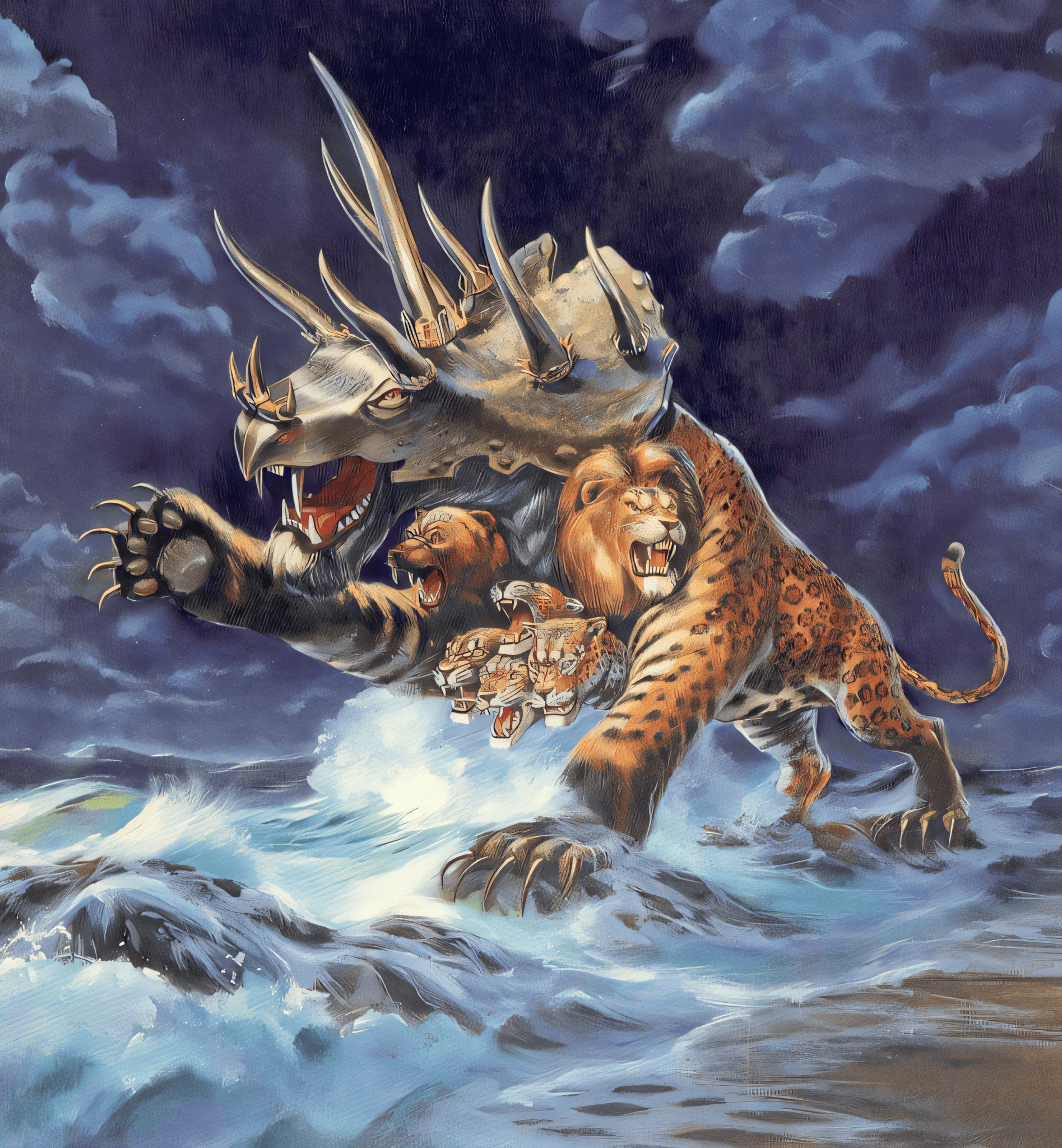Ah, Watson, let us approach this puzzle with the same keen eye with which we might unravel a case of grand conspiracy and layered intrigue. Picture, if you will, the grand narrative spun by the Apostle John in Revelation 13:1-3, laden with symbols that draw heavily from Daniel’s visions. The passage begins with John standing upon the sands of the sea, evoking Daniel’s vision by the “great sea” where beasts emerged one by one. Yet, John’s perspective is unique, a panoramic view from the end times where the culmination of these beasts—their shared legacy—manifests as a singular, composite entity.
Let us first dissect the symbolism of these beasts as kingdoms, as Daniel himself interpreted. In his vision, the succession began with Nebuchadnezzar’s Babylon, followed by the Medo-Persian Empire, then the Grecian Empire with its four-headed beast, and finally the formidable Roman Empire. John’s account, however, casts a wider net, encompassing all empires that influenced Israel, starting from ancient Babylon and tracing through to the “one is” of his own day—the Roman Empire. Notably, John also includes Britain, whose fleeting dominion over Palestine secured its place as the seventh head. The British Empire’s contribution, symbolized by its brief mandate and the pivotal Balfour Declaration, paved the way for modern Israel’s existence, lending profound significance to its role.
Now, Watson, observe the enigma of the eighth beast, “one of the seven,” yet distinct and standing apart as an “eighth.” This final empire is a rebirth of the Grecian-Roman lineage, but with deeper roots in ancient Babylon—the city whose ambitious tower epitomized rebellion against the divine (Genesis 11:1-9). In this revived Roman-Babylonian amalgam, John’s beast embodies the culmination of power, ascending from the abyss with dark energy fueled by Satanic influence and the whispered lore of fallen angelic technology (2 Thess. 2:9; Daniel 9:27). The beast’s splendor is deceptive, inspiring awe and false worship among the masses as it parades its seemingly invincible might (Revelation 13:3-4).
This mortally wounded head—ancient Babylon itself—“was and is not,” submerged under the sands until its resurrection as the capital of this new empire. When it falls once more, by the might of a coalition from the north—Russia, Iran, and Turkey—its destruction marks both judgment and a significant wound to the beast (Jeremiah 50:3, 13, 39-40; 51:29; Revelation 18:2-10). The question of whether this demise unfolds through nuclear fire or some divine cataclysm remains unanswered, yet the symbolism implies a cataclysm of immense scale.
The nuanced interpretations of the “mortal wound” in Revelation 13:3 and the “deadly wound” healed in Revelation 13:12 require careful separation. The first, a fatal blow to Babylon, signals the end of its dominance, while the second, a sword stroke, weakens but does not kill—indicating the empire’s survival amid turmoil. These distinct references serve to illustrate Babylon’s cyclical fate: once slain and buried, now resurrected to usher in the end-time rebellion, only to face ultimate destruction under divine judgment (Jeremiah 51:63-64; Isaiah 13:19-22).
Turning our gaze to the ten horns, we recognize them as ten kings who rise with the Assyrian King of the North—Adonikam, the Antichrist, and final ruler of this empire (Daniel 7:7-10, 23-27; 8:9-14; Revelation 17:12-13). With Babylon’s fall, the empire reels, plunging the world into a depression described in Revelation 18:11-19. Yet, from the turmoil, Britain and America emerge—embodiments of the beast with two lamb-like horns. Their strength prompts adversaries such as Russia to pause. These nations, Watson, equipped with secretive technologies gleaned from supposed extraterrestrial encounters, represent the pinnacle of deception and power. The notion that advanced crafts could be felled by lightning—a clever fabrication indeed—masks the true origin of such devices: a legacy of Satan’s cunning, distributed subtly over decades.
With their technological might, these nations harness the first quantum computing AI, linking the world into a network that enforces the “666 Mark economy,” a membership economy under total surveillance and control (Revelation 13:13-17). The leaders of once-Christian nations, now speaking like dragons, support the Antichrist’s iron-fisted rule. Economic sanctions, symbolic of cutting off the lifeblood of any nonconforming nation, align with this prophecy, enforcing compliance under the most severe threat.
So, Watson, we see before us a web of interconnected symbols—each head, horn, and wound a clue that pieces together a grand and terrible tapestry. The revived Roman-Babylonian empire, underpinned by Satanic power, rises with the ambition of ancient Babel, only to meet its foretold end under divine retribution.
That is how we solve the mystery of the Beast having seven heads and ten horns that John saw rising up out of the sea in Revelation 13:1-3
1 And I stood upon the sand of the sea, and saw a beast rise up out of the sea, having seven heads and ten horns, and upon his horns ten crowns, and upon his heads the name of blasphemy.
2 And the beast which I saw was like unto a leopard, and his feet were as the feet of a bear, and his mouth as the mouth of a lion: and the dragon gave him his power, and his seat, and great authority.
3 And I saw one of his heads as it were wounded to death; and his deadly wound was healed: and all the world wondered after the beast. (Rev. 13:1-3 KJV)
